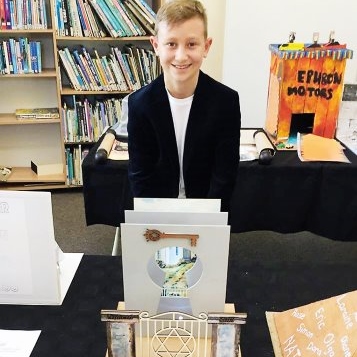click to dowload our latest edition
CLICK HERE TO SUBSCRIBE TO OUR NEWSLETTER


Published
5 years agoon
By
adminJORDAN MOSHE
Shur’s project was one of three worldwide to receive the title of “exceptional submission”, and Matisonn’s submission won him a ticket to Tel Aviv in June to take part in celebrations held by Beit Hatfutsot, the Museum of the Jewish People.
The My Family Story international competition is a global educational programme sponsored by the museum which gives Jewish youth the opportunity to explore their family roots, historical memory, and Jewish family values, and express their ideas using creativity and artistic skill.
More than 20 000 participants submitted projects from 25 countries this year, out of which 50 students won tickets to Israel to display their project at the museum in a two-day programme, including a ceremony and prize giving.
In South Africa, the four participating schools, Torah Academy Girls’ High, King David Linksfield, Victory Park, and Sandton Primary School, showcased the magnificent works of art produced by the students at exhibitions held at the schools. Judges Liat Amar-Arran, the director of the Israel Centre SA; Kim Nates and Courtneigh Bernstein from the Johannesburg Holocaust & Genocide Centre; and Partnership2Gether Chairman Anthony Rosmarin were hard-pressed to choose winning projects from among the many submissions. Matisonn and Shur were among the nine winners selected.
A student of King David Sandton, Matisonn’s project, “The Golden Key”, was selected to be one of the displays at Beit Hatfutsot. The product of countless hours of brainstorming for an original idea, the project represents a unique chapter of the family’s history. Matisonn explains that his great-great-great grandfather, Isaac Woolf Baranov, came from Lithuania and first settled in Grimsby in the United Kingdom, moving to Vryheid in South Africa thereafter.
“He was presented with a gold key at the opening of a shul in Vryheid in 1904,” Matisonn says. “His wife, Hannah, had brought from Europe a Torah scroll and many Judaica items required for a shul. Shul services were held in their home for 17 years until they had the funds to build a permanent shul, which ran for 83 years.”
He continues, “We were convinced that a shul had already been submitted in this project previously, but thought that it was unlikely that another family had a gold key to a shul that was built 115 years ago. The key represents hope that even when there are hardships, such as leaving home for a place of uncertainty, Judaism is given priority. My grandfather, Ken Baranov, now has the key, as it has been handed down from generation to generation, and he hopes future generations will unlock the door to Jewish practices.”
Matisonn and his mother, Tanya, spent three weeks on the project, working closely with information gathered by Baranov. “My mom and I thought that if we submitted a key as our project it would not be creative enough,” said Matisonn. “We used the theme of keys, locks, gates, and the shul to make my project. At the back of the project is a painting of the original shul with large wooden cut outs of door locks in front of the shul painting, so you have to look through the key lock to see the shul.”
“My grandfather spent years researching his family history, travelling to Lithuania, Poland, Grimsby, and Vryheid. It’s fulfilling to be able to use all the information gathered regarding our heritage.”
A proud South African, Matisonn is excited to be representing his country in the competition, and said he could not believe it when his name was announced as a winner.
“I was in awe when my Jewish Studies teacher then called to say the museum in Israel had selected my project for a trip to Israel,” he said. “It is so amazing that the competition programme is held in Tel Aviv, as Israel is home for all of us. I am so excited to meet people my age from all over the diaspora, and celebrate together in a special place that is meaningful to all of us.”
Shur, a student at King David Linksfield, was also thrilled at the recognition given to his submission, “Zaida’s Bucket”. A tribute to his great grandfather Issy Krost, the project is modelled on a steel bucket Krost crafted himself for use in his plumbing business in South Africa after leaving the shtetl of Keidan in Lithuania in 1929.
“This bucket was inspired by a bucket which was used in their home in Keidan to draw water,” said Shur. “Many Krost customers liked the bucket, and asked him to make one for them. It was the start of a new steel manufacturing company called the Krost Brothers.” The company produced items like pots, pans, and toolboxes, eventually even making kitchen units and shelves.
A cousin visiting Keidan in 2012 actually found the original bucket, providing further inspiration for the project. “The bucket was found by the well,” Shur said. “It was still being used. Even though very old, it stood the test of time. It connects me to my Jewish roots and culture, and it symbolises the physical strength and durability of the Jewish people in the face of hardship. We have the inner strength and determination, with the help of Hashem, to overcome any situation.”
One of only three submissions worldwide to receive the title of exceptional submission, he will be awarded the “Prize Hitztaynut”, and will also receive a special mention at the competition. A video of the presentation, which was sent to judging committee, will be on view as part of the exhibit. Although Jesse’s display itself wasn’t selected for the exhibit, the video (with added subtitles) will be seen by the thousands of people visiting the museum in June and July.
